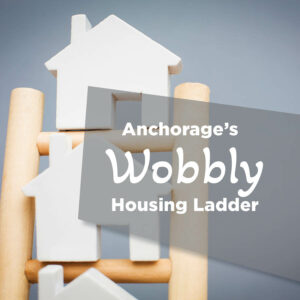
Published in Anchorage Daily News 01.03.2024
By Connie Yoshimura
A Housing Ladder consists of all housing units of various sizes, types and price points in a market. It is a house, an apartment, a mobile home, a group of rooms, or a single room that is occupied (or if vacant, one that is intended for occupancy) as separate living quarters. Separate living quarters are those in which the occupants live and eat separately from any other persons in the building and which have access from the outside of the building or thorough a common hall. For example, I live in a duplex and my tenant has its own kitchen, exterior door and garage. If I were to put an interior door into the unit, it would be reclassified as a single housing unit. The more ‘rungs’ that exist on the housing ladder, the more space it creates for residents seeking housing of all types. Expanding the housing ladder and making the ‘rungs’ stronger by adding new housing at each level creates new move-up opportunities for others seeking to enter the market regardless of where on the ladder they begin. As they move into new housing units, more housing capacity is made available in the homes they are vacating. This process repeats itself across all rungs on the ladder. The only way to strengthen our housing ladder is to add new housing units of all sorts. Anchorage, including Girdwood and Eagle River, has 118,055 housing units. Over 50% of these units are now over 42 years old which means they have reached their functional and economic obsolescence. Consequently, our ‘Housing Ladder’ is weakening every year we do not build new units to replace the deteriorating rungs on the ladder, including those units that were destroyed by fire and condemnation.
Despite the MOA’s recent best efforts to fix the over-regulation which stymies and delays the construction of new units, we are continuing to fail. In 2023, there were approximately 136 single family building permits, compared to 179 in 2022. I say approximately only because the permits we have pulled for Nov/Dec. do not segregate duplexes. There were only 74 multi-family units permitted compared to 168 in 2022. Both numbers are painfully depressing for a population of 292,452 where homeownership is 62.88%, which is below the national average of 65.1%.
And for those of you who are frustrated and bewildered about our local housing situation, here is what I say to you. We all regret not buying a home on Dec. 17, 2020 when mortgage rates plummeted to an historic 2.67% but that time has passed and I doubt we will ever see that rate again. And for those of you who are even willing to pay today’s rate of 6.6% but can’t find a home to purchase because your highest and best offer was turned down by escalating cash offers, our only solution to the wobbly housing ladder is to loosen the reins of over regulation and change our zoning rules to encourage mixed density despite the potential for NIMBY (Not Im My Backyard)_attitudes of neighbors. If you want to strengthen our housing ladder and improve our communities, then you must speak out for more housing now—of all housing types and locations. That is a big ask because I know that in order for your family to afford to purchase a home, you must now work 1.5 jobs per household and at the end of today still have to drive the the kids to soccer or basketball practice. You are probably not going to make it to the community council meeting where all these discussions start. I hear about your frustration and disappointment with the local housing market from my realtors, and I encourage you to voice your housing needs at the local level with your elected officials.
PS. And for those of you who have yet to take the first step on the housing ladder away from renting or living in your parents’ basement, I encourage you to take a serious look at the condominium market. As of yesterday, there were only 52 condos for sale but with an average sales price in the last six months of $274,051, it remains Anchorage’s best housing buy.

 Connie Yoshimura is the Owner and Broker of Berkshire Hathaway HomeServices Alaska Realty. With over 40 years of residential real estate experience, she continues to be a leader in Alaska’s housing market. Most recently, she sold the highest-priced home ever recorded in the Alaska MLS.
Connie Yoshimura is the Owner and Broker of Berkshire Hathaway HomeServices Alaska Realty. With over 40 years of residential real estate experience, she continues to be a leader in Alaska’s housing market. Most recently, she sold the highest-priced home ever recorded in the Alaska MLS.
Leave a Reply